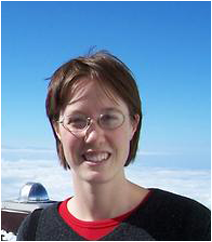 |
 |
 |
 |
 |
 |
 |
 |
 |
 |
|
KICP Workshops & Events
|
PhD Thesis Defenses, 2008 Hiroaki Oyaizu, "N-body simulations of modified gravity" June 5, 2008 | 1:30 PM | RI 480  Scientific Advisor: Andrey V. Kravtsov We introduce the method and the implementation of a cosmological simulation of a class of metric-variation f ( R ) models that accelerate the cosmological expansion without a cosmological constant and evade solar-system bounds of small-field deviations to general relativity. Such simulations are shown to reduce to solving a non-linear Poisson equation for the scalar degree of freedom introduced by the f ( R ) modifications. We detail the method to efficiently solve the non-linear Poisson equation by using a Neton-Gauss-Seidel relaxation scheme coupled with multigrid method to accelerate the convergence. The simulations are shown to satisfy tests comparing the simulated outcome to analytical solutions for simple situations, and the dynamics of the simulations are tested with orbital and Zeldovich collapse tests. Finally, we present several static and dynamical simulations using realistic cosmological parameters to highlight the differences between standard physics and f ( R ) physics. In general, we find that the f ( R ) modifications result in stronger gravitational attraction that enhances the dark matter power spectrum by ~ 20% for large but observationally allowed f ( R ) modifications. More detailed study of the non-linear f ( R ) effects on the power spectrum are presented in a companion paper. Related Links: KICP Members: Andrey V. Kravtsov KICP Students: Hiroaki Oyaizu Jennifer Siegal-Gaskins, "Revealing dark matter substructure with anisotropies in the diffuse gamma-ray background" June 13, 2008 | 10:00 AM | LASR conference room  Scientific Advisor: Angela V. Olinto The majority of gamma-ray emission from Galactic dark matter annihilation is likely to be detected as a contribution to the diffuse gamma-ray background. I show that dark matter substructure in the halo of the Galaxy induces characteristic anisotropies in the diffuse background that could be used to determine the small-scale dark matter distribution. I calculate the angular power spectrum of the emission from dark matter substructure for several models of the subhalo population, and show that features in the power spectrum can be used to infer the presence of substructure. The shape of the power spectrum is largely unaffected by the subhalo radial distribution and mass function, and for many scenarios I find that a measurement of the angular power spectrum by GLAST will be able to constrain the abundance of substructure. An anti-biased subhalo radial distribution is shown to produce emission that differs significantly in intensity and large-scale angular dependence from that of a subhalo distribution which traces the smooth dark matter halo, potentially impacting the detectability of the dark matter signal for a variety of targets and methods. Related Links: KICP Members: Angela V. Olinto KICP Students: Jennifer M. Siegal-Gaskins Scientific projects: Fermi Gamma-ray Space Telescope (Fermi) Charles Shapiro, "The effects of neglecting reduced shear on dark energy constraints from three-dimensional weak lensing methods" July 24, 2008  Scientific Advisor: Michael S. Turner The weak gravitational lensing of distant galaxies by large-scale structure is expected to become a powerful probe of dark energy. By measuring the ellipticities of large numbers of background galaxies, the subtle gravitational distortion called "cosmic shear" can be measured and used to constrain dark energy parameters. The observed galaxy ellipticities, however, are induced not by shear but by reduced shear, which also accounts for slight magnifications of the images. This distinction is negligible for present weak lensing surveys, but it will become more important as we improve our ability to measure and understand small-angle cosmic shear modes. I calculate the discrepancy between shear and reduced shear in the context of power spectra and cross spectra, finding the difference could be as high as 10% on the smallest accessible angular scales. I estimate how this difference will bias dark energy parameters obtained from two types of 3D weak lensing methods: weak lensing tomography and the shear ratio method known as offset-linear scaling. For weak lensing tomography, ignoring the effects of reduced shear will cause future surveys such as the Dark Energy Survey, Large Synoptic Survey Telescope, or Joint Dark Energy Mission to bias their dark energy parameters by amounts that are comparable to their error bars. I advocate that reduced shear be properly accounted for in these surveys, and I provide a semi-analytic formula for doing so. For a space telescope such as the Joint Dark Energy Mission, the offset- linear scaling method is insensitive to reduced shear for modes l <= 3000, but the method becomes invalid when including modes with l >= 5000. Reduced shear could have important consequences for other observables such as the weak lensing of the cosmic microwave background. Related Links: KICP Members: Michael S. Turner KICP Students: Charles Shapiro Matthew Sharp, "Measuring small-scale anisotropy in the Cosmic Microwave Background with the Sunyaev-Zel'dovich Array" July 28, 2008 Online Materials Scientific Advisor: John E. Carlstrom Using the Sunyaev Zel'dovich Array (SZA), an eight-element interferometer observing at 30 GHz, we make a measurement of the fluctuation power spectrum of Cosmic Microwave Background (CMB) anisotropy on angular scales corresponding to several arcminutes. Within this range, we expect the primary CMB to be greatly damped and dominated by secondary contributions, especially the Sunyaev Zel'dovich Effect from intermediate-mass galaxy clusters. We measure 93 ± 66°K 2 of power in 44 fields with the SZA. We attribute 30°K^2 of this power to primary CMB, and a further ~ 5 - 10°K^2 to galactic dust grains that are spinning. We believe that we have accounted for all power contributed by radio point sources. The remaining 60 - 66°K^2 of power we attribute to the Sunyaev Zel'dovich Effect, consistent with simulations of structure with s 8 = 0.8. While previous measurements have shown some tension with such a low value of s 8 , we see no such tension. We introduce the measurement with a brief description of s 8 and its role in the standard cosmological model, and then describe the SZA and our observations. The analysis that we have conducted is described in detail, as well as our interpretation of the results. Related Links: KICP Members: John E. Carlstrom KICP Students: Matthew Sharp Scientific projects: Sunyaev-Zeldovich Array (SZA) Benjamin E. Dilday, "Type Ia supernova rate studies from the SDSS-II Supernova Study" July 28, 2008 Online Materials Scientific Advisor: Joshua A. Frieman I present new measurements of the type Ia SN rate from the SDSS-II Supernova Survey. The SDSS-II Supernova Survey was carried out during the Fall months (Sept.-Nov.) of 2005-2007 and discovered [approximate]500 spectroscopically confirmed SNe Ia with densely sampled (once every [approximate] 4 days), multi- color light curves. Additionally, the SDSS-II Supernova Survey has discovered several hundred SNe Ia candidates with well-measured light curves, but without spectroscopic confirmation of type. This total, achieved in 9 months of observing, represents [approximate] 15-20% of the total SNe Ia discovered worldwide since 1885. I describe some technical details of the SN Survey observations and SN search algorithms that contributed to the extremely high- yield of discovered SNe and that are important as context for the SDSS-II Supernova Survey SN Ia rate measurements. I describe 3 separate SN Ia studies: (1) A precise measurement of the SN Ia rate at low-redshift ( z < 0.12) based on a highly pure sample of SNe Ia with a well measured selection function. (2) A measurement of the type Ia SN rate to a redshift limit z [Special characters omitted.] 0.3, based on [approximate] 350 SNe Ia. (3) A measurement of the type Ia SN rate in galaxy clusters in the redshift range 0.03 < z < 0.30. The low-redshift SN Ia rate measurement includes 17 SNe Ia at redshift z <= 0.12. Assuming a flat cosmology with O m = 0.3 = 1 - O L , we find a volumetric SN Ia rate of [Special characters omitted.] SNe Mpc -3 [Special characters omitted.] year -1 , at a volume-weighted mean redshift of 0.09. This result is consistent with previous measurements of the SN Ia rate in a similar redshift range. The systematic errors are well controlled, resulting in the most precise measurement of the SN Ia rate in this redshift range. We use a maximum likelihood method to fit SN rate models to the SDSS-II Supernova Survey data in combination with other rate measurements, thereby constraining models for the redshift-evolution of the SN Ia rate. Fitting the combined data to a simple power-law evolution of the volumetric SN Ia rate, r V 0( (1 + z ) b , we obtain a value of b = 1.5 ± 0.6, i.e. the SN Ia rate is determined to be an increasing function of redshift at the ~ 2.5s level. Fitting the results to a model in which the volumetric SN rate, r V = Ar(t) + B[Special characters omitted.] (t), where r(t) is the stellar mass density and [Special characters omitted.] (t) is the star formation rate, we find A = (2.8 ± 1.2) × 10^-14 SNe [Special characters omitted.] year -1 , B = [Special characters omitted.] SNe [Special characters omitted.] . The SN rate measurement to a redshift limit z [Special characters omitted.] 0.3 provides an order of magnitude improvement in the statistics for SN Ia rate measurement in this redshift range. Although systematic uncertainties on the SN rate for 0.2 < z < 0.3 are significant, the SN rate is determined precisely for z [Special characters omitted.] 0.2 based on a sample of [approximate] 132 SNe Ia, with the majority being spectroscopically confirmed. The large sample of SNe Ia included in this study allow us to place constraints on the redshift dependence of the SN Ia rate in the redshift range covered by the SDSS-II Supernova Survey, based on the SDSS-II Supernova Survey data alone. The SN rate in galaxy clusters has been measured with much less statistical significance than the cosmic SN rate due in part to the relative rarity of galaxy clusters. The measurement of the cluster SN Ia rate from the first two seasons of the SDSS-II Supernova Survey includes 5 events in clusters at z [Special characters omitted.] 0.17 (c4 clusters), and 12 events in clusters in the redshift range 0.1 < z < 0.3 (maxBCG clusters). There are additionally 3 SNe Ia in low-redshift c4 clusters from the third season of the SDSS-II Supernova Survey. These measurements represent significant contributions to the study of the SN rate in galaxy clusters, in terms of both statistical significance and redshift coverage. We find values of the SN Ia rate of [Special characters omitted.] SNuM h 2 and [Special characters omitted.] SNuM h 2 in c4 and maxBCG clusters, respectively. The SN rate in galaxy clusters as a function of redshift is consistent with a constant rate, which supports the idea that cluster SNe Ia are primarily produced by an old stellar population, with a rate that is weakly dependent on time delay with respect to star formation. (Abstract shortened by UMI.) Related Links: KICP Members: Joshua A. Frieman KICP Students: Benjamin E. Dilday Scientific projects: SDSS Supernova Survey (SDSS SS) Marcos Lima, "Non-linear Structure in Modified Action Theories of Gravity" July 29, 2008 | 1:30 PM | AAC 123 Online Materials Scientific Advisor: Wayne Hu We study the effects and carry out a suite of cosmological simulations of modified action f(R) models where cosmic acceleration arises from an alteration of gravity instead of dark energy. These models introduce an extra scalar degree of freedom which enhances the force of gravity below the Compton scale of the scalar. The simulations exhibit the so-called chameleon mechanism, necessary for satisfying local constraints on gravity, where this scale depends on environment, in particular the depth of the local gravitational potential. We find that the chameleon mechanism can substantially suppress the enhancement of power spectrum in the non-linear regime if the background field value is comparable to or smaller than the depth of the gravitational potentials of typical structures. Nonetheless power spectrum enhancements at intermediate scales remain at a measurable level even when the expansion history is indistinguishable from a cosmological constant, cold dark matter model. We also investigate the effects of the modified dynamics on halo properties such as their abundance and clustering. We find that the f(R) effects on the halo mass- function and bias depend mostly on the linear power spectrum modifications, but that the chameleon mechanism suppresses the modifications at high-mass halos with deep potential wells. The f(R) modifications also affect the threshold density for collapse, or similarly the overdensity for virialization and therefore can change halo definitions from those of ACDM. As a result, simple scaling relations that take the linear matter power spectrum into a non-linear spectrum fail to capture the modifications of f(R) due to the change in collapsed structures, the chameleon mechanism, and the time evolution of the modifications. A quantification of these effects, including modifications on halo profiles, is necessary to accurately describe halo properties and potentially construct a halo model of the non-linear power spectrum. Related Links: KICP Members: Wayne Hu KICP Students: Marcos V. Lima Carlos Cunha, "Cross-Calibration of Cluster Mass-Observables and Dark Energy" July 31, 2008 | 2:00 PM | AAC 123  Scientific Advisor: Joshua A. Frieman This paper is a first step towards developing a formalism to optimally extract dark energy information from number counts using multiple cluster observation techniques. We use a Fisher matrix analysis to study the improvements in the joint dark energy and cluster mass-observables constraints resulting from combining cluster counts and clustering abundances measured with different techniques. We use our formalism to forecast the constraints in O DE and w from combining optical and sz cluster counting on a 4000 sq. degree patch of sky. We find that this joint "self-calibration" yields ~ 41-64% better constraints on O DE and w compared to simply adding the Fisher matrices of the individually self-calibrated counts. The joint constraints are less sensitive to variations in the mass threshold or maximum redshift range. A by-product of our technique is that the correlation between different mass-observables is well constrained without the need of additional priors on its value. Finally, we compare results from combining optical and sz surveys to two sz-like surveys and find that combining surveys with different properties yields the best constraints. Related Links: KICP Members: Joshua A. Frieman KICP Students: Carlos E. Cunha Sarah Hansen, "Correlating Optical and Sunyaev-Zel'dovich Measurements of Galaxy Clusters in the SZA Survey" August 1, 2008 | 11:00 AM | AAC 123  Scientific Advisor: Stephan S. Meyer The interferometric cm-wave data from the Sunyaev-Zel'dovich Array survey were cross-correlated with galaxy clusters identified in a companion R and z ' optical imaging program conducted at Kitt Peak National Observatory with the Mosaic-1 camera on the 4m Mayall telescope. These optical data were reduced using pipelines designed for the similar data set of the RCS survey to produce a catalog of clusters. The average SZ signal correlated with this set of clusters and several sub-samples was measured. A negative correlation between the optical and radio data of the Sunyaev-Zel'dovich Array survey was measured at the 1-sigma level. Based on the optical mass proxies of detection significance and richness, the estimated average mass of the cluster samplea is approximately 1 x 10 14 solar masses. The average correlated SZ signal is consistent with this estimate, as is the temperature decrement measurement recovered from an MCMC analysis of a beta-model fit to the low-richness clusters. In all, there is a consistent picture of the average SZ signal being able to be recovered for an ensemble of clusters despite the mass of all systems individually being below the detection threshold of the SZA survey. Related Links: KICP Members: Stephan S. Meyer KICP Students: Sarah M. Hansen Scientific projects: Sunyaev-Zeldovich Array (SZA) |





 Overview
Overview